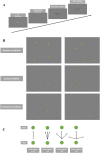Intact animacy perception during chase detection in ASD
- PMID: 28928448
- PMCID: PMC5605503
- DOI: 10.1038/s41598-017-12204-x
Intact animacy perception during chase detection in ASD
Abstract
We explored the strength of implicit social inferences in adolescents with and without Autism Spectrum Disorder (ASD) using a chasing paradigm in which participants judged the absence/presence of a chase within a display of four seemingly randomly moving dots. While two of these dots always moved randomly, the two others could fulfill the role of being either the chasing (wolf) or chased (sheep) dot. In the chase-present (but not the chase-absent) trials the wolf displayed chasing behavior defined by the degree to which the dot reliably moved towards the sheep (chasing subtlety). Previous research indicated that chasing subtlety strongly influenced chase detection in typically developing (TD) adults. We intended to replicate and extend this finding to adolescents with and without ASD, while also adding either a social or a non-social cue to the displays. Our results confirmed the importance of chasing subtlety and indicated that adding social, but not non-social, information further improved chase detection performance. Interestingly, the performance of adolescents with ASD was less dependent on chasing subtlety than that of their TD counterparts. Nonetheless, adolescents with and without ASD did not differ in their use of the added social (or non-social) cue.
Conflict of interest statement
The authors declare that they have no competing interests.
Figures



Similar articles
-
The psychophysics of chasing: A case study in the perception of animacy.Cogn Psychol. 2009 Sep;59(2):154-79. doi: 10.1016/j.cogpsych.2009.03.001. Epub 2009 Jun 4. Cogn Psychol. 2009. PMID: 19500784
-
Perceptual animacy: visual search for chasing objects among distractors.J Exp Psychol Hum Percept Perform. 2014 Apr;40(2):702-17. doi: 10.1037/a0034846. Epub 2013 Dec 2. J Exp Psychol Hum Percept Perform. 2014. PMID: 24294872
-
What are the underlying units of perceived animacy? Chasing detection is intrinsically object-based.Psychon Bull Rev. 2017 Oct;24(5):1604-1610. doi: 10.3758/s13423-017-1229-4. Psychon Bull Rev. 2017. PMID: 28160268
-
Perception of animate motion in dogs.Front Psychol. 2025 Jan 3;15:1522489. doi: 10.3389/fpsyg.2024.1522489. eCollection 2024. Front Psychol. 2025. PMID: 39830849 Free PMC article. Review.
-
Are we compulsively chasing rainbows?Neuropsychopharmacology. 2022 Nov;47(12):2013-2015. doi: 10.1038/s41386-022-01419-w. Epub 2022 Aug 18. Neuropsychopharmacology. 2022. PMID: 35982236 Free PMC article. Review. No abstract available.
Cited by
-
Effect of Object on Kinesthetic Motor Imagery in Autism Spectrum Disorder: A Pilot Study Based on Eye-Tracking Methodology.Neuropsychiatr Dis Treat. 2024 Jan 24;20:167-183. doi: 10.2147/NDT.S435258. eCollection 2024. Neuropsychiatr Dis Treat. 2024. PMID: 38282833 Free PMC article.
-
The right temporoparietal junction during a cooperation dilemma: An rTMS study.Neuroimage Rep. 2021 Jul 9;1(3):100033. doi: 10.1016/j.ynirp.2021.100033. eCollection 2021 Sep. Neuroimage Rep. 2021. PMID: 40567287 Free PMC article.
References
-
- American Psychiatric Association. Diagnostic and statistical manual of mentaldisorders (DSM-5®) (American Psychiatric Publishing, 2013).
-
- Baron-Cohen, S. Mindblindness: An essay on autism and theory of mind. (Cambridge,MA: MIT Press, 1995).
-
- Baron-Cohen S. Theory of mind and autism: A review. Int. Rev. Res. Ment. Retard. 2001;23:169–184. doi: 10.1016/S0074-7750(00)80010-5. - DOI
-
- Begeer S, Malle BF, Nieuwland MS, Keysar B. Using Theory of Mind torepresent and take part in social interactions: Comparing individuals with high functioning autism and typically developing controls. Eur. J. Dev. Psychol. 2010;7:104–122. doi: 10.1080/17405620903024263. - DOI
Publication types
MeSH terms
LinkOut - more resources
Full Text Sources
Other Literature Sources
Medical

